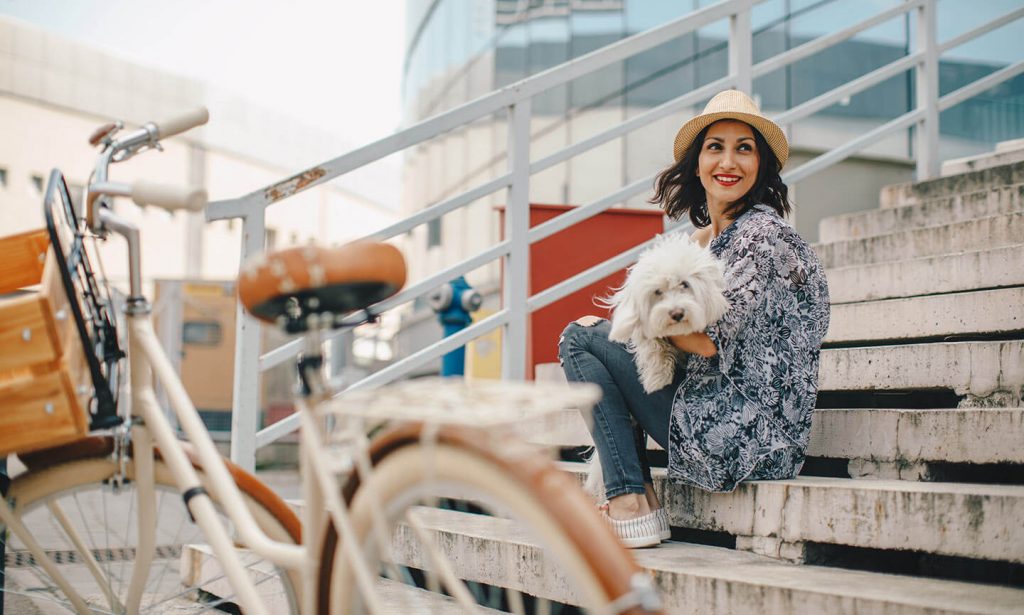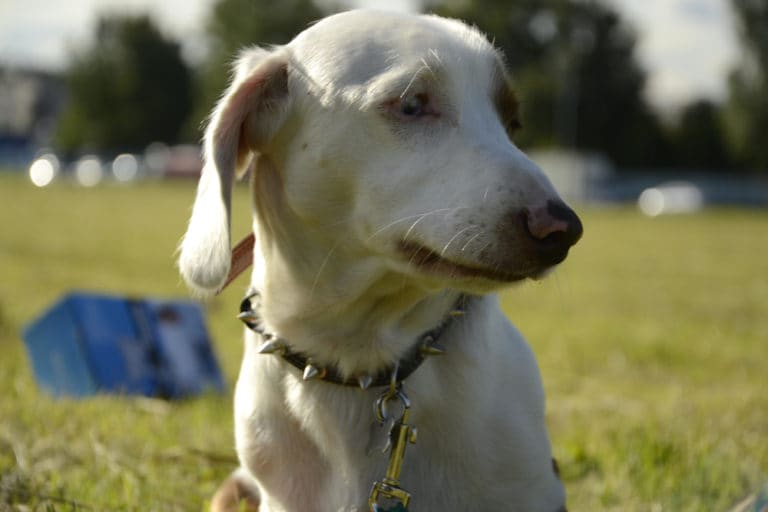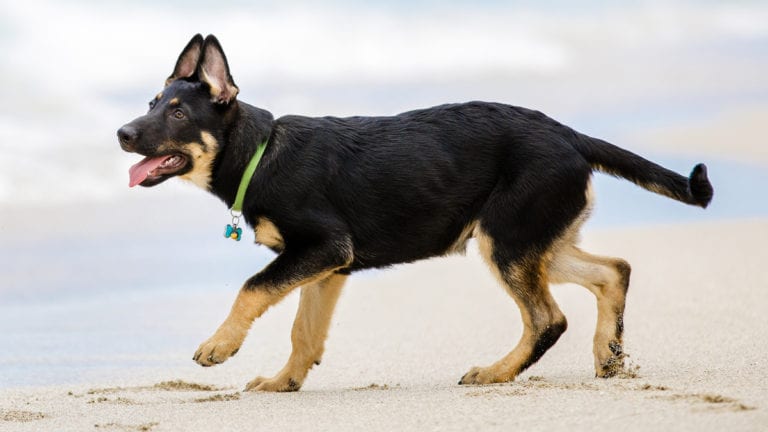Is there a more freeing feeling than pedaling on a bike with the wind in your hair and sunshine on your cheeks? The only way it could get better is if your favorite pup was by your side, either jogging alongside your bicycle or sitting pretty in a front basket. Going on a bike with a dog in tow can be a great way to bond and celebrate the great outdoors—but how does a pair of would-be bikers get started?
From safety precautions to must-have supplies, here’s what you need know to go bike riding with a dog.
At a Glance...
- Bike riding with your dog is a great way to spend more time together while engaging in a more active lifestyle.
- Be sure to have some basic commands and obedience training down pat before attempting a bike ride with your pup.
- There are two basic ways to go bike riding with a dog: You can have them jog alongside you on a specially designed leash, or have them ride in a dog basket or bike trailer.
Before You Bike With a Dog…
Making time to train your dog is incredibly important before going on that first bike ride together. Any pet parent who’s gone walking with their pup understands how quickly a leisurely stroll can take a turn for the worse when your dog decides to chase after a critter or is distracted by another dog or person. In that same vein, your dog should also be calm, cool and collected around bikes, skateboarders, runners and anything else they may encounter on the bike path.
For starters, your dog should already be a pro at walking by your side on a leash—and that includes being responsive to your pace (slowing down when you slow down and speeding up when you speed up). If not, this will be your first step.
“Your pup must be able to walk with you without pulling ahead and without darting after birds, squirrels, or anything else,” says Lauren Novack, ACDBC, KPA-CTP, FPPE, a certified dog trainer and associate certified dog behavior consultant for Behavior Vets of NYC.
Learn how to properly leash train your dog here.
“Your dog should [also] have basic training and respond to some basic commands,” also notes Dr. Mary R. Burch, Ph.D., a certified applied animal behaviorist and director of the American Kennel Club’s (AKC) Family Dog program.
If you plan on having your pup jog alongside your bike, Dr. Burch recommends your dog knows the following commands:
- Watch me
- Turn
- Come
- Slow and hurry (to change pace)
- Stop or "whoa"
You can practice these are verbal cues when out on a walk or run for “real world” experience that’s less consequential. If your dog is struggling to focus, try practicing these commands in a quiet space or consider working with a trainer or behaviorist to expedite your success.
Learn more about teaching your dog commands like “Watch Me,” and “Come,” here.
How to Go Bike Riding With a Dog Safely
There are two different methods for riding a bike with a dog: with a leash or in a trailer or basket.
Method 1: Biking With a Dog on a Leash
If you plan to use a harness and leash while bike riding with a dog, it’s important that the pup is in good physical shape.
“Running alongside a bike is an aerobic activity, and as with any exercise program the first step to keeping your dog safe is having your veterinarian check your dog and approve the activity,” says Dr. Burch.
If your pet’s not quite there yet, talk to your vet about getting your pup started on a training program of sorts: Start with short leisurely walks, move on to intervals of jogging and walking and then do a few runs together. Once your pet has built that endurance and their body is prepared to handle the impact of a run alongside your bike, you can move forward. Always default to your vet’s recommendation on the appropriate exercise regimen and pace.
On that note, puppies, as well as dogs who are very small, have injuries or are older aren’t ideal candidates for bike riding via harness and leash. We recommend using a dog basket or trailer instead (more on that below).
What You'll Need:
Once your dog is physically prepared, you can ease them into actual bike riding.
They’ll need a comfortable harness, like the OneTigris Tactical Vest Nylon Front Clip Dog Harness, and a hands-free leash with some give, such as Hertzko Nylon Reflective Bungee Hands-Free Running Dog Leash or Surf City Pet Works Reflective Bungee Hands-Free Running Dog Leash.
These leashes can be worn around your waist or clipped to the bike itself, allowing you to safely steer the bike with your hands. Many also feature a bungee-like design to keep it from tangling or dragging.
How to Get Started:
Now that you have your vet’s OK and the necessary supplies, here’s how to begin bike riding with your dog, according to Novack:
- Practice makes perfect! Begin by going for a walk with your dog while pulling your bike along by the handlebars. Reward your dog with treats for staying by your side.
- Next, walk with the bike between your legs (we know, it’s awkward!), alternating between walking and peddling slowly. Pause frequently to teach your pup to stay by your side.
- Once your dog starts getting the hang of it, you can begin to peddle more and walk less. Pay attention to their pace, and slow down if they’re lagging behind. And don’t forget to reward them frequently for successfully jogging alongside you—even if it’s for a short distance.
- Keep practicing until you’re a bike riding duo!
Expect the process to take at least a few days, if not more, based on your dog’s experience.
“If your pup is already well mannered, is conditioned to running, and enjoys training, you may be able to do this in a few days,” says Novack. “If your pup has never run before or has no training experience, the process could take much longer.”
Go with the flow, be attentive to your dog’s needs and be patient. If they seem uncomfortable or afraid of the bicycle, you can try again in a few days to see if they gradually become more comfortable. But if the situation doesn’t improve, bike riding may just not be for your pup.
Remember that this activity should be enjoyable for the both of you, so don’t force your beloved dog to do something they aren’t ready for. You can find other outdoor activities to do together here.
Method 2: Biking With a Dog Trailer or Basket
Some dogs just aren’t made for the bike riding life, but you don’t have to write off your human-and-dog cycling dreams just yet.
Using a dog basket or bike trailer is an excellent way to get some warm-weather quality time in with your pup. Don’t just get any ol’ basket, though: You’ll want to choose a carrier that’s specifically made for this activity due to the additional safety features they have. (See sidebar.)
Before attempting, be sure go over the commands like “stay” and “watch me.”
Distractions can still cause safety issues, like your pup trying to break free from the basket or trailer, so having these under your belt will likely make everything go smoother.
What You'll Need:
We recommend the K&H Pet Products Travel Dog Bike Basket and Snoozer Pet Products Sporty Dog Bike Basket, thanks to their safety tethers. If you prefer a trailer, consider the Trixie Premium Quick Fold Dog Bike Trailer. With a memory foam pad and mesh screens your dog can ride in both comfort and style.
Depending on the type of trailer you get, you might also need something like the Petique All Terrain Dog & Cat Jogging Stroller Bike Adapter to properly attach it to your bike.
How to Get Started:
Whether using a dog basket or a bike trailer, it is imperative that your dog is securely strapped in to prevent potential injury, says Novack. Utilize the tethers that is likely in the dog basket or trailer you chose, and Novack also recommends having your dog wear a harness instead of a collar, so they won’t put strain on their neck if they begin to become anxious.
Also, it’s important your dog is comfortable with bike and their new carrier: “You would approach this much in the same way you would approach crate training,” she says. Here’s her advice on how to get started:
- Before heading outside, leave the basket or trailer out in your living space, so your dog can get used to this new object.
- Give them treats and tons of praise while sitting in the basket or trailer.
- Once they seem comfortable with it, choose a quiet area for your first bike ride and secure the carrier to your bicycle.
- After securing your pet, begin pedaling slowly, ensuring that they are comfortable with the pace. Stop frequently to give praise and treats.
Like bike riding with a leash, the activity could take some getting used to. Again, going slowly and pausing if your dog seems anxious is key.
Whatever route you take when you bike with a dog, your dog’s health and safety are top priorities. Try to stick to shady areas to prevent sunburn, avoid long periods of time outdoors when it’s too hot or too cold and always bring food and water. It’s also a good idea to stay away from rough terrain and busy streets (quiet locales are ideal) and to be mindful of how your dog’s feeling so you can adjust accordingly.
Go slow, be patient and have fun with it!
Share:
















